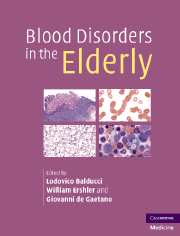Book contents
- Frontmatter
- Contents
- List of contributors
- Preface
- Part I Epidemiology
- Part II Hematopoiesis
- Part III Anemia of aging
- Part IV Hematologic malignancies and aging
- 18 Cancer chemotherapy in the older person
- 19 Acute myeloid leukemia in the elderly
- 20 Acute lymphoblastic leukemia in the elderly patient: diagnosis and therapy
- 21 Multiple myeloma
- 22 Non-Hodgkin lymphoma
- 23 Unusual lymphomas in the elderly
- 24 Chronic lymphocytic leukemia in the elderly
- 25 Polycythemia vera and idiopathic myelofibrosis in the elderly
- Part V Disorders of hemostasis in the elderly
- Index
19 - Acute myeloid leukemia in the elderly
from Part IV - Hematologic malignancies and aging
Published online by Cambridge University Press: 21 October 2009
- Frontmatter
- Contents
- List of contributors
- Preface
- Part I Epidemiology
- Part II Hematopoiesis
- Part III Anemia of aging
- Part IV Hematologic malignancies and aging
- 18 Cancer chemotherapy in the older person
- 19 Acute myeloid leukemia in the elderly
- 20 Acute lymphoblastic leukemia in the elderly patient: diagnosis and therapy
- 21 Multiple myeloma
- 22 Non-Hodgkin lymphoma
- 23 Unusual lymphomas in the elderly
- 24 Chronic lymphocytic leukemia in the elderly
- 25 Polycythemia vera and idiopathic myelofibrosis in the elderly
- Part V Disorders of hemostasis in the elderly
- Index
Summary
Introduction
Acute myeloid leukemia (AML) is a clonal hematologic malignancy characterized by proliferation and accumulation of myeloid progenitors within the bone marrow, leading ultimately to hematopoietic failure. In the peripheral blood, there is often profound pancytopenia, with the attendant complications of infection and bleeding. In some patients, the white blood count may become markedly elevated, resulting in leukostatic complications such as cerebrovascular or cardiovascular insufficiency. AML may occur de novo or arise secondarily from pre-existing clonal hematologic diseases such as myelodysplastic syndrome (MDS) or myeloproliferative syndromes. In rare cases, AML may develop as a consequence of exposure to previously administered chemotherapeutic agents such as alkylators or epipodophyllotoxins.
Recent years have witnessed an expanded understanding of AML, in terms of both pathophysiology and classification. Several new oncogenes and molecular targets have been discovered, therapies directed at these targets have been developed, and notable advances in supportive care through antibiotics and blood-product support are undisputed. Despite these advances, however, AML remains incurable in the majority of patients. In the case of older patients, outcomes are especially dismal. This chapter will examine the epidemiologic, biologic, and therapeutic aspects of AML that are unique to older individuals, highlighting the challenges associated with treating such patients.
- Type
- Chapter
- Information
- Blood Disorders in the Elderly , pp. 237 - 255Publisher: Cambridge University PressPrint publication year: 2007



